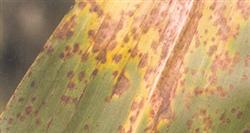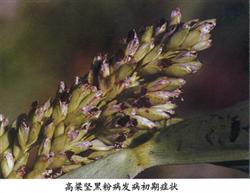Occurrence and control of head smut in sorghum

Due to the continuous expansion of sorghum planting area and the extension of planting years, the harm of head smut of sorghum is becoming more and more serious, which directly affects the production and development of sorghum. First, the degree of damage sorghum head smut occurred sporadically only in some areas of the county in the early 1990s. By the year 2000, it occurred in an area of about 43 hectares in individual villages and towns, with a disease rate of 15%, and light occurrence in other planting areas. According to the investigation in 2004, the affected area of the county was 800ha, accounting for 34% of the total sown area of sorghum, and the average rate of diseased plants in the diseased field was 20.5%. In 2005, the infected area of the county was 1333 ha, accounting for 67% of the total sown area of sorghum, and the average rate of diseased plants in the diseased field was 31.2%. In the sorghum planting area of the second brigade of Bestobie township, the rate of infected plants reached 70.5% and the severity was 70%. Second, the disease mainly harms the ear, the diseased plant is shorter than the healthy plant, and the damaged sorghum ear becomes a large ash bag. After the outer membrane is broken, a large amount of black powder is released, and a bunch of scattered filaments are exposed at the same time. In a few cases, only part of the inflorescence was killed, or obvious gray nodules appeared on the leaves at the end, and the vascular bundles of the leaves did not break after the adventitia was ruptured. Third, the incidence regularity of sorghum head smut, which is called sorghum smut, belongs to basidiomycete subphylum fungi. The main results are as follows: 1, the pathogen can be transmitted through seeds and soil, the bacteria scattered in the soil can survive for 1 year, and the winter spores can survive for 3 years in the deep soil. Winter spores scattered in soil or manure are the main source of infection in this county. two。 The disease process was observed in sorghum field from 2004 to 2005. the suitable sowing date of sorghum was late April and seedling emergence was generally in early May. During this period, the ground temperature of 0: 20 cm was 18.5-26.2 ℃, the average daily temperature was 24 ℃, and the daily precipitation was 3.3ml, which was most favorable for winter spore germination of sorghum head smut. After winter spore germination, binuclear hyphae invaded the young buds of sorghum. After the seedling stage, the spores of the pathogen were no longer infected, and no damage symptoms were seen in the seedling stage. The invaded hyphae entered the growth vertebra tissue after 35 days and the differentiated flower buds after 60 days. At the sorghum heading stage from late July to mid-August, the diseased ear was pulled out before the ash bag appeared and was not broken. 3. ① temperature and humidity the pathogen of sorghum head smut is closely related to soil temperature and water content. The incidence of soil temperature is 28 ℃ and soil water content is 15%. When sowing in spring, the soil moisture is low or the soil cover is too thick, the seedlings are slowly unearthed and prone to disease. When sorghum was planted in ② rotation, sorghum head smut occurred seriously, and the longer the rotation time was, the lighter the disease was. The degree of disease resistance of different ③ varieties was different, and the disease in the field was different. The disease of fine sorghum varieties selected from disease-free areas or disease-free fields was relatively mild, while the disease of varieties selected from self-breeding or disease-free areas was serious. Fourth, prevention and control measures 1. At present, the hybrids resistant to head smut are Heiza 34, Qiza 1 and so on. two。 Rotation with other crops for more than 3 years can effectively control the occurrence of the disease. 3. Deep sterilization in autumn can reduce the source of bacteria and reduce the disease next year. 4. For seed treatment, soak the seeds in 45-55 ℃ warm water for 5 minutes, then sow the seeds immediately after the seeds germinate, which can not only protect the seedlings but also reduce the incidence of disease; seed dressing, use 25% zolidone wettable powder 2 grams mixed with 1 kg sorghum seeds, or use 50% verapamil powder 35 grams mixed with 5 kg seeds, mix and sow seeds. 5. Sowing at the right time, improve the sowing quality, make the seedlings unearthed as soon as possible, and reduce the chance of germs invading from the seedlings. 6. Pull out the diseased ear before the ash bag appears and before it is broken, concentrate on the deep burial or burning outside the field.
- Prev

Sorghum anthracnose
Symptom the disease is an important disease of sorghum, which occurs in all producing areas of sorghum. The disease can be infected from seedling stage to adult stage. Infection at seedling stage is harmful to leaves, resulting in withered leaves and death of sorghum seedlings. The disease spot of the leaf is fusiform, the middle is reddish brown, the edge is purplish red, and there are dense small black spots on the disease spot, that is, the pathogen conidium disk. Anthrax.
- Next

Head smut of sorghum
Symptomatic diseased plants are shorter than healthy ones. At the initial stage of the disease, the ear bud of the diseased ear is very tight, the lower part is dilated, the flag leaf is straight, and the endophytic white rod can be seen, that is, Wumi. The black rice in the bracts is small at the beginning, finger-like, gradually growing, and the middle part of the posterior part is expanded into a cylindrical, harder. Wumi in the process of development, the internal tissue from white to black, after opening.
Related
- The first cup of black tea in spring, the flavor and history of tea gardens in Kenya, Africa
- The computer can not only choose potatoes, but also grow tea rice. AI will grow winter oolong tea champion.
- It is not only the inflated tea bitten by insects, but also engraved with the four seasons tea in Beipu.
- The Oriental Beauty Tea Festival in Zhuxian County takes the stage at the weekend to experience the plus-size feast of oil tea.
- & quot; Oriental Beauty Tea & Exploration of Emei in Hsinchu, the hometown of quot;
- The new variety of strawberry "Tainong 1" dessert is the first choice with mellow aroma. Crimson gorgeous
- History of Tea in Taiwan: from Wild Inner Mountain to Export Tea Garden
- Two types of Taiwan Oriental Beauty Black Tea won the British three-Star Award for Childhood Tea Xiang Zhang Jiaqi changed from pilot to champion tea maker.
- Banana species and varieties: the planting history of Taiwan Xianren banana and dwarf banana is long, is banana disease resistant?
- Coffee planting Technology: Qianjie Coffee from Seedling to harvesting

